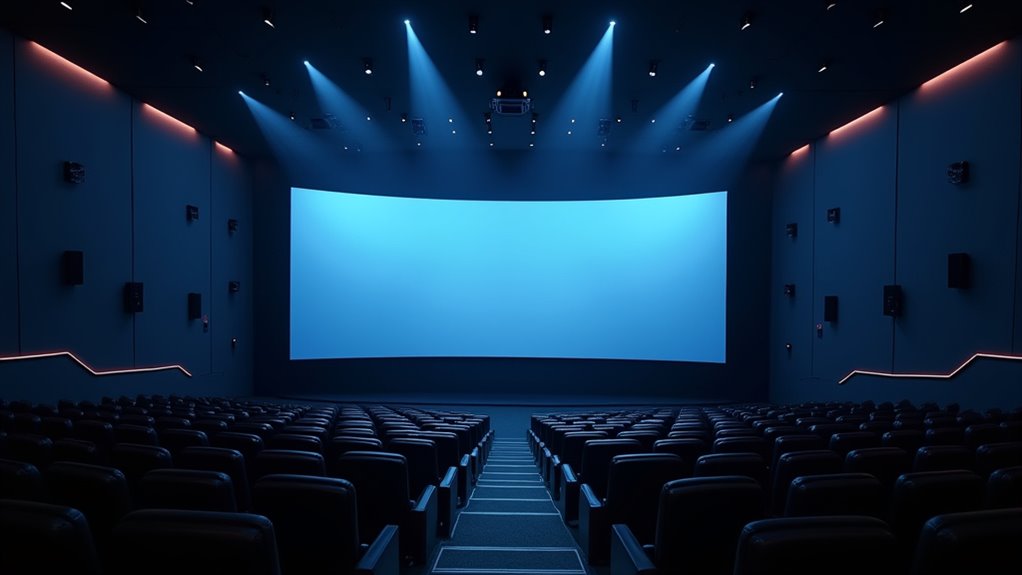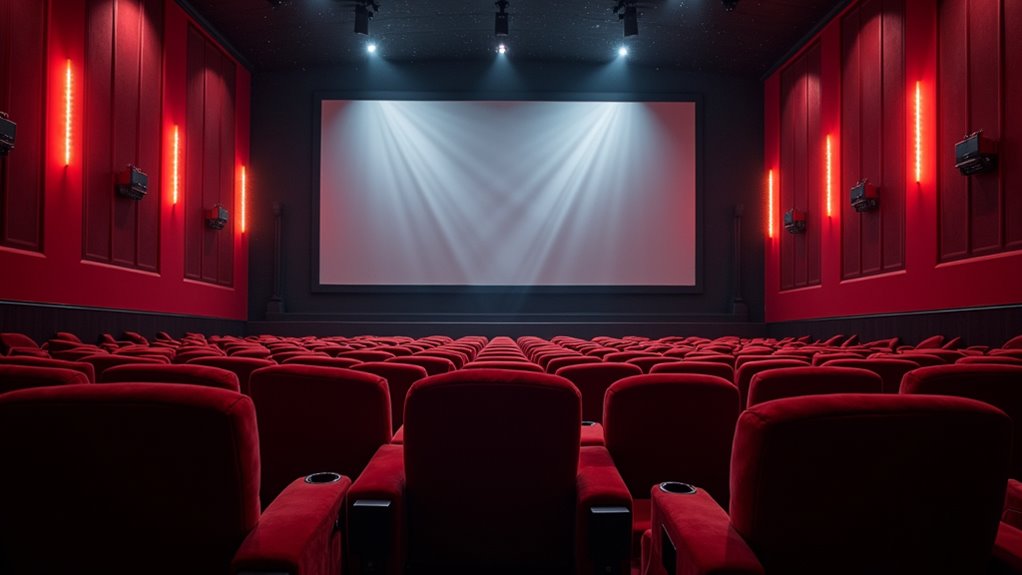Movie theaters combine cutting-edge technology with timeless communal rituals to create unmatched entertainment experiences. Modern cinemas feature immersive 360-degree projection systems, powerful audio arrays, and 4D motion seats that synchronize with on-screen action. The shared atmosphere of collective gasps, laughter, and silence transforms personal entertainment into cultural touchstones, while advanced digital production methods continue pushing boundaries. Understanding these elements reveals how theaters maintain their magical allure in today’s entertainment landscape.
The Science Behind Theater’s Immersive Power

While countless moviegoers flock to theaters for entertainment, the science behind cinema’s immersive power reveals a sophisticated interplay of cutting-edge technology and human psychology.
Modern theaters leverage full-dome projection systems boasting up to 11 million pixels, creating a seamless 360-degree visual embrace that tricks our brains into total immersion.
This technological marvel pairs with precisely engineered audio systems, where 10,000-watt sound arrays and object-based audio placement create a cocoon of sensory stimulation.
The combination of stadium-style seating, panoramic screens, and advanced projection techniques doesn’t just dazzle – it fundamentally alters how our brains process the experience.
Research shows these immersive environments trigger stronger emotional responses and enhance memory retention, explaining why that heart-pounding chase scene or tear-jerking farewell feels so real.
The science confirms what movie buffs have long suspected: there’s simply no replacement for the crafted perfection of a proper theater setup.
Some premium theaters feature horizontal film format technology that produces images up to 8.3 times larger than standard film formats.
Theaters now offer 4D motion seats that synchronize with on-screen action to deliver an even more spectacular viewing experience.
The Koch Immersive Theater demonstrates this principle with its 360-degree immersive experience that makes viewers feel enveloped in the story rather than simply watching it unfold.
Why Shared Movie Moments Matter
Although modern theaters dazzle audiences with cutting-edge technology and pristine audiovisual experiences, the true magic of cinema emerges through its ability to forge meaningful connections between strangers sitting shoulder-to-shoulder in the dark.
The collective gasps during plot twists, synchronized laughter at well-timed jokes, and shared silence in poignant moments create an invisible thread of community that enhances the storytelling experience.
These shared moments transcend the mere act of watching a film, fostering cultural exchange and strengthening social bonds within communities.
Movie theaters serve as cultural hubs where diverse groups converge, creating lasting memories and shared references that ripple through social networks. Even before recorded sound, theaters enhanced the viewing atmosphere with live musical accompaniment.
The amplified emotional responses in a packed theater often exceed individual reactions, transforming personal entertainment into a collective journey. This phenomenon reflects how stories are privileged in human cognition, naturally drawing people together through shared narrative experiences.
Like ancient storytellers gathering tribes around campfires, modern cinemas continue to unite people through the timeless art of shared narrative experiences. Beyond entertainment, these gatherings provide essential stress relief through collective emotional release and social connection.
Modern Cinema’s Evolution and Future

Despite rapid technological changes reshaping entertainment, modern cinema continues to evolve through a fusion of cutting-edge innovation and time-tested storytelling traditions. From virtual production techniques seen in groundbreaking shows like “The Mandalorian” to immersive audio experiences with Dolby Atmos, theaters are embracing technological advancement while preserving the communal viewing experience. Similar to streaming services that revolutionized television viewing habits, theaters have adapted to changing audience expectations.
Modern filmmaking artfully weaves new technology with classic storytelling, creating immersive experiences that honor cinema’s communal heart.
The industry has witnessed remarkable transformations in both production and presentation. Filmmakers now utilize drone cinematography and light field cameras, while theaters implement smart solutions like mobile apps and premium amenities. Advanced digital audio workstations have revolutionized sound design, enabling unprecedented control over theatrical soundscapes. The introduction of massive LED walls has transformed traditional filming by creating real-time interactive environments for actors.
The rise of streaming hasn’t spelled doom for cinemas; instead, it’s pushed them to innovate with VR experiences, themed screenings, and enhanced viewing environments. Looking ahead, sustainability and accessibility drive industry evolution, as digital production reduces environmental impact and new distribution channels reach broader audiences.
Modern cinema stands at the intersection of tradition and innovation, proving that the magic of movies can adapt while maintaining its essential appeal.
Frequently Asked Questions
What Are the Best Seats to Choose in a Movie Theater?
The optimal movie theater seats are located two-thirds back from the screen, slightly off-center, providing both ideal viewing angles and superior sound quality.
While front rows strain necks and corner seats distort audio, the sweet spot combines a 36-degree viewing angle with balanced surround sound.
For IMAX experiences, sitting closer can enhance immersion, though maintaining reasonable distance prevents visual fatigue and ensures maximum enjoyment.
How Early Should I Arrive Before a Movie Showing?
Moviegoers should arrive 20-30 minutes before showtime at standard theaters, while dine-in venues like AMC or Studio Movie Grill warrant a 30-minute buffer.
Drive-in theaters require at least 30 minutes for optimal parking and setup.
Early arrival allows time for ticket collection, concession purchases, and comfortable seating selection without rushing.
Those who’ve pre-ordered tickets online can shave off 5-10 minutes from these recommendations.
Are Outside Snacks and Drinks Allowed in Movie Theaters?
Major theater chains like AMC, Regal, and Cinemark strictly prohibit outside food and beverages, as concession sales represent roughly 40% of their revenue.
While some moviegoers attempt to sneak in snacks to avoid high concession prices, this practice violates theater policies.
Those with dietary restrictions or cost concerns might consider eating before or after the show, or consulting theater staff about specific needs.
Which Days Typically Offer the Best Movie Ticket Discounts?
Tuesdays consistently offer the most competitive movie ticket discounts across major theater chains, with both AMC and Cinemark featuring significant price reductions.
Matinee showtimes, typically before 6 PM, provide another reliable opportunity for savings.
While weekend prices tend to be highest, many theaters offer special family rates on designated weeknight evenings, and summer months often feature dedicated discount programs for family-friendly films.
How Do Movie Theaters Handle Disruptive Audience Members During Screenings?
Movie theaters employ various strategies to handle disruptive patrons, from initial verbal warnings to removal from the premises.
Staff members typically monitor screenings periodically and respond to complaints from other viewers. Some chains, like Alamo Drafthouse, maintain strict zero-tolerance policies for talking and phone use, while others rely on pre-show announcements and posted conduct guidelines.
Limited staffing can affect enforcement capabilities, leading many theaters to depend on patron reporting.
